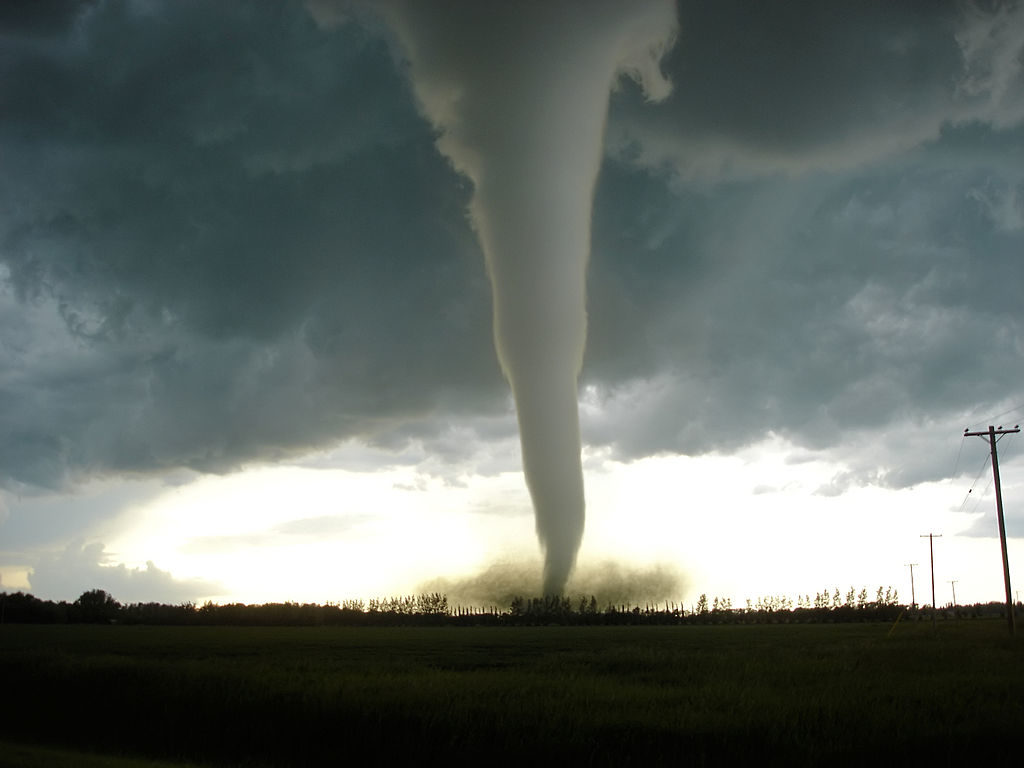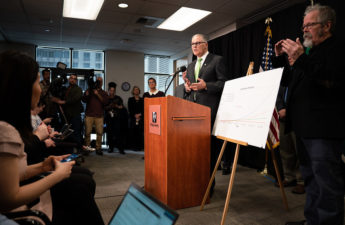
By: Tim Henderson, Stateline
Gerardo Ramirez, a central Texas dairy worker, was near his home but taking an unusual route to a children’s hospital in April when he drove his Volkswagen Jetta into a flooded section of road, not seeing in the pre-dawn dark that heavy rains had turned a tiny creek into a death trap. Ramirez survived, but his wife and two children drowned.
In March, 800 miles away in Lee County, Alabama, 23 people ranging in age from 6 to 93 were killed in a 170 mph tornado — despite an evacuation warning by local authorities just like ones that many residents had heeded in previous storms this year.
The deadly situations illustrate what experts increasingly see as two common reasons for unnecessary storm deaths: unfamiliar terrain that leads to bad decisions, and people ignoring too-familiar warnings that haven’t panned out in the past.
Harnessing new prediction technology, federal authorities hope to sharpen the disaster warnings they send directly to cellphones, as well as to state and county emergency managers, to make the warnings faster and clearer about life-threatening conditions. They want to alert people like the Ramirez family who may be on unfamiliar terrain as unexpected disasters like flash floods, tornadoes or wildfires unfold.
At the same time, social scientists working for the federal government are interviewing storm survivors like those in Lee County, gathering information for future advances in disaster warnings to combat “response fatigue” that can wear down people’s sense of urgency, as apparently happened in Alabama.
Some of those who stayed put in Lee County had well-thought-out plans to evacuate, including gathering supplies, rounding up children and identifying a relative or friend in a more substantial house, according to Kim Klockow McClain, who interviewed survivors.
“They rely on family resources, and frankly it can take all day to go and wait. People were losing money,” said Klockow McClain, a scientist at the National Severe Storms Laboratory in Oklahoma, a research lab of the National Oceanic and Atmospheric Administration. “They just didn’t go that day. It’s as simple as that.”
To try to prompt residents to take action, in September, the National Weather Service will change flash flood warnings to specifically mention if the threat is “considerable” or “catastrophic,” said Daniel Roman, a Maryland-based hydrologist at the National Weather Service. Officials will make that call based on information from local weather spotters, radar evidence of tornado debris or computer detection of conditions that caused storms in the past.
The “considerable” flooding category calls for “urgent action” by residents and local authorities “to preserve lives and property,” while the “catastrophic” category means waters are “rising to levels rarely, if ever, seen” and will “threaten lives and cause disastrous damage.”
In November, after that system is in place, flood warnings sent to cellphones nationwide will be cut back to only those in the considerable or catastrophic category, less than 10% of the 12,000 flood warnings now issued every year to cellphones and local authorities, Roman said.
“The idea is that you cut back on the number, so you don’t get the public desensitized,” Roman said. Warnings about more routine floods will still go out in other forms but won’t buzz the area’s cellphones.
The background noise of too many warnings can be just as dangerous as no warning at all.
“There are all these warnings and people are still driving into floodwaters,” said W. Craig Fugate, a Federal Emergency Management Agency chief during the Obama administration and a former director of the Florida Division of Emergency Management.
“You can say ‘Turn around, don’t drown,’ but there are so many flash flood warnings that people tune them out and don’t realize this one is more destructive,” Fugate said. “Breaking through the noise is the challenge.”
Impact-based warnings are already in place for tornadoes.
The idea came up after tornadoes killed 553 people across the country in 2011, the worst year since 1925, with more than 400 deaths in Alabama and Missouri alone, despite warnings in place in most cases.
When the National Weather Service interviewed people in Joplin, Missouri, where 158 people had died, they heard that most residents relied on community tornado sirens to learn of an approaching twister, and turned to other sources like friends or television for confirmation before seeking shelter.
The service concluded that shorter, more specific warnings would prompt more people to protect themselves, and the warnings went national in 2018 after a demonstration project in the South.
But not everyone agrees. Klockow McClain, who is both a meteorologist and a social scientist stationed in Oklahoma for the National Severe Storms Laboratory, is a skeptic about impact-based warnings, calling them “fear-based.”
“You can’t control people and force them into taking certain actions through fear,” Klockow McClain said, adding that warnings should include more specifics on what people should do, not just the impacts that could result from a storm.
While many people have the impression that residents ignore disaster warnings, her experiences interviewing survivors led her to a different conclusion.
“People are thinking about it, they’re looking for confirmation and trying to decide on the best course of action,” Klockow McClain said. “Sometimes meteorologists will criticize people for looking outside for a sign of the storm, but that’s a very natural instinct.”
Floods, tornadoes, wildfires and hurricanes killed 226 people last year, according to federal statistics.
There already have been 38 deaths from tornadoes and 67 from flooding this year; two-thirds of the flooding victims were in vehicles. They include 10 deaths in Texas, six in Kentucky and five in Missouri.
In recent years, the Wimberley floods in Texas contributed to a nationwide flooding-related death toll of 186 in 2015, and in 2017 Hurricane Harvey inundated Houston, contributing to 182 deaths.
The new format for flood warnings comes as the National Weather Service revamps other warnings to make them shorter and more specific about damage. Starting Sept. 24, the service will cut back and simplify warnings on everything from fog to ice.
Impact-based warnings include more specifics to help people visualize what could happen — for instance, a severe hailstorm warning might say “people and animals outdoors will be severely injured,” said Gregory Schoor, severe storms leader for the National Weather Service.
Where disasters are a familiar part of life, people know the drill and generally respond quickly to disaster warnings and evacuation orders, many emergency managers say.
Tornadoes hit El Reno, Oklahoma, in 2011 and again in 2013, when a 2.6-mile-wide storm, the widest ever recorded in the United States, killed eight people including three well-known storm chasers.
There was little warning in May before the latest tornado in El Reno, which killed two as it shredded mobile homes and blew Dumpsters into motel rooms, said Andrew Skidmore, Canadian County’s emergency manager.
But with the area’s history as part of Oklahoma’s Tornado Alley, residents are not complacent about the threat, Skidmore said. The county provides shelters in public schools for people who need them, like mobile home residents.
“People here are always looking at the sky and turning on the TV, and the news outlets here do a really good job of keeping people up to date and telling them what they need to do,” Skidmore said. “There’s no sense of complacency here.”
Familiarity breeds caution along flood-prone creeks in the North Carolina mountains, said David Vance, Avery County’s emergency management coordinator.
“People who live along these creeks watch very carefully and know when it’s time to get away,” said Vance, adding that the county has a “reverse 911” system to automatically call homes with flood alerts.
Even in the area south of Dublin, Texas, where the Ramirez tragedy unfolded in April, residents near the road know that heavy rain can cause treacherous floods, said Erath County’s emergency management coordinator, Susan Driskill.
After heavy rain the night before and a severe thunderstorm watch issued about 3 a.m. that day, state transportation workers had barricaded flooded roads, but the road Ramirez took had not yet flooded at that time, Driskill said.
The Ramirez family was coming from nearby Comanche County, making a special trip to a hospital where a dental operation with anesthesia was scheduled for one of the children, Driskill said.
“Those creeks can rise very quickly. Folks around here are aware of that,” said Driskill, adding that residents follow the county’s Facebook page for alerts and call her to report flooding or grass fires that threaten homes.
“They don’t like to evacuate. They’re going to stay with their property,” she said of the area’s residents, including many dairy farmers who make the county one of the state’s top milk producers.
Meteorologists have recently begun to recognize the need to sharpen weather predictions to get attention in areas where residents may not be used to life-threatening storms. Klockow McClain said social science-oriented meteorologists like herself are still in the “diagnosis phase” and don’t have all the answers yet on what will motivate people to act more consistently on unexpected disaster warnings.
Klockow McClain’s work is funded by the government and aimed at helping develop a future system of feedback from disaster survivors about the warnings they heard and how they reacted, she said. The Lee County, Alabama, emergency services director, Kathrine Carson, said she was surprised to hear some people may not have evacuated, since there were more people than usual in a church basement shelter near the hardest-hit area.
Keith Seitter, director of the American Meteorological Society, said meteorologists look to research like Klockow McClain’s for guidance on how to tailor future warnings for maximum effect.
“This is an issue for all meteorologists, and we take it very seriously,” Seitter said.


